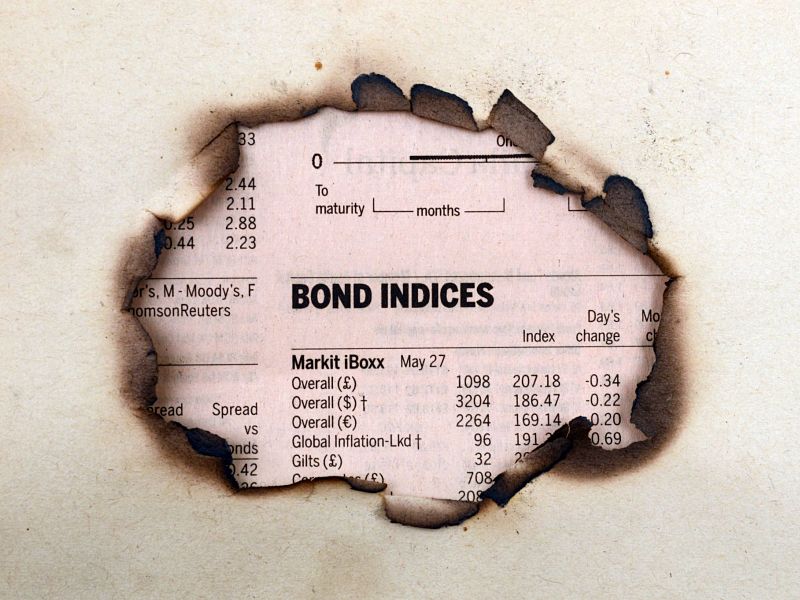

In its March report, IIF said “a wave of downgrades from BBB- to sub-investment-grade could force institutional investors with strict investment grade mandates to reduce exposures abruptly, resulting in ‘fire sales’”. That moment has arrived. “In the U.S., 15% of investment-grade bonds are at risk of becoming fallen angels,” reports Addenda Capital’s Yanick Desnoyers. This equates to 58 issuers in the US, and 30 issuers in Europe. Use Overbond’s bond screening and market surveillance tools to identify issuers who are on the cusp of downgrades.
Source: MorningStar
There is a problem in the corporate bond market. In the run-up to the 2008 global financial crisis, world corporate debt (excluding financials) stood at 75% of global GDP, according to the Institute of International Finance. By early March 2020, that figure ballooned to 93%, around US$75 trillion, of which $12 trillion was made up of non-financial corporate bonds, with a little more than half rated BBB-, just above a junk rating. From 2008 to present, the number of BBB- bonds quadrupled.
The questionable quality of this corporate debt causes the IIF to worry. In its March report, it said “a wave of downgrades from BBB- to sub-investment-grade could force institutional investors with strict investment grade mandates to reduce exposures abruptly, resulting in ‘fire sales’”. That moment has arrived.
Fire Sales
In a June 11 Weekly Insight, the IIF reported that the face value of defaulted non-financial corporate bonds has jumped to $70 billion in Q2 2020 – the largest on record – with U.S. firms accounting for two-thirds of the total.
“In the U.S., 15% of investment-grade bonds are at risk of becoming fallen angels (down-rated to junk status: BB+ or lower),” reports Yanick Desnoyers, vice-president and senior economist at Addenda Capital. The bond indices have “identified 58 issuers totalling US$300 billion which are at risk. In Europe, there are 30 issuers for $150 billion. In Canada, we don’t have a dollar total, but the percentage is lower at 5% because the sectors most vulnerable are already in the junk zone. That includes areas like retail, media and entertainment, cars, oil and gas.”
Analysts note that this vulnerability in bonds is the main reason why the Federal Reserve and the Bank of Canada have initiated purchases of individual corporate bonds and corporate bond ETFs. Not only is corporate solvency at stake, but “there are large companies in there that hire a lot of people whose jobs are in jeopardy,” highlights Desnoyers.
However, the activity of the Fed as a bond market backstop is “fairly restrained, and not as pervasive as we might think on the surface, especially when it comes to high-yield bonds,” claims David Stonehouse, senior vice-president and head of North American specialty investments at AGF Investments. “Out of a total balance sheet of US$7 trillion, only US$10 billion have been devoted to investment-grade bonds and a smaller portion to high-yield bonds.” In fact, the Fed “backstop effect” is largely dependent on intention more than deed, Stonehouse claims.
A Fine Line
The line dividing the lowest investment-grade bonds (BBB-) from non-investment grade or “junk” status (BB+, BB and lower) is a sensitive one. Once a bond dips into that lower zone, many mutual funds and insurance companies cannot continue to hold it and must sell in order to find other more kosher issues.
However, nobody seems overly anxious. “We are not talking of a rout in any way, says Desnoyers. This won’t blow the bond market apart. There are still hundreds of billions of dollars worth of issues that will be made.” Stonehouse agrees, “By the time the rating agencies make a downgrade, large parts of the market have already front-run the impact and sold as rate spreads have widened, and many will snap up issues at a discount. You see a first negative impact of selling while spreads widen, but they then narrow as a new wave of buyers move in. Prices can drop by 20% and quickly come back, even go above; that creates opportunities for a speedy profit.”
Be Cautious with Opportunities
The dip into a below-investment-grade rating can represent an opportunity for many investors who are willing to venture into high-yield territory, but it is not for the faint of heart. “That opportunity is not before the downgrade, only after,” warns Crista Caughlin, a portfolio manager specializing in bonds at Mawer Investment Management. She also advises investors to be very wary and selective if they are to venture into high-yield bonds or ETFs. “Central banks are providing a ton of liquidity and creating moral hazard by actually funding investments that would otherwise not be funded. When central banks start withdrawing their support and that liquidity, it is from those low-quality issues that it will be siphoned out.”
In the present context, all three specialists recommend that investors exercise caution. Investors should know what stance they want to adopt in the bond portion of their portfolio. “How much do you want to hold in solid investment grade issues? Select issuers accordingly, and look for solidity of profits, strength of balance sheet and market stability,” counsels Desnoyers.


